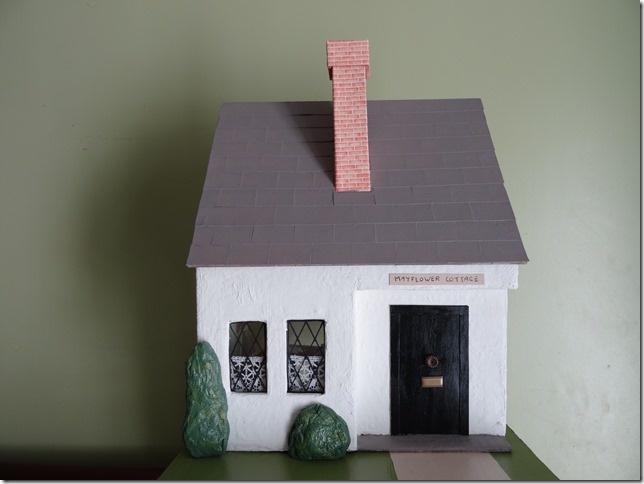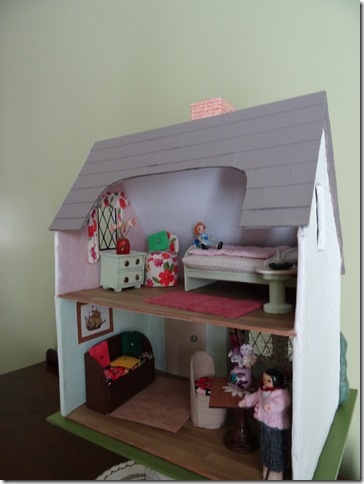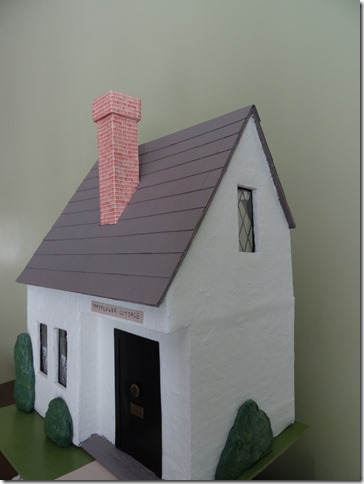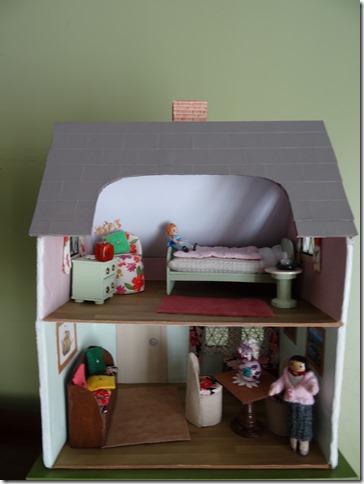Many readers may, like me, have conceived the laudable ambition to fill the endless hours of lockdown stretching before us with a dolls’ house, emerging at the other end with an actual achievement.
Isobel Ridley managed it, using only materials she had to hand. She says she has mis-spent many years cutting up cardboard and there is a certain degree of wonkiness. (To those of us with years occupied assessing photographs of miniaturists cookie-cutter houses, all made from the same kit, the individuality is the goal that turns the hobby into art.)
The base is 21cm by 25 cm and 28.5 cm to the top of the chimney. The exterior is similar to the Triang Mayflower 50 House (from the catalogue pages in Marion Osborne’s book but made into two storeys with the additions of the porch and extra shrubs.) The original Mayflower was backless, Isobel has cut away the roof to access the upstairs bedroom.
Isobel’s house was once a box holding packets of coffee. The walls are double thickness and the corners are reinforced with paper strips. The base is the back of a pad of cartridge paper, the floors and roof are cut from a shoebox, which was made of lovely thick card. Tiles were cut in strips from various packets, mostly biscuits. The inside walls were all lined, before painting with emulsion testing pots. The exterior walls were also papered before rendering with kitchen roll and wallpaper paste. The lattice work in the windows is cut paper, painted black and varnished. Isobel says it was a fiddly job, but she had a lot of time on her hands.
Chairs and the bedside table are cotton reels, the bed is from the shoe box, the table is a chess piece and a piece of wood. The masterpiece is the chest of drawers, made from a halved matchbox, with the halves stacked and re-glued.
Miss Peg was made by a friend and dressed by Isobel, the doll on the bed is by J. Laverick, dressed by Isobel.
Curtains are scraps of fabric, the blanket is a place mat. The shrubs are cardboard covered with paper and paste.
Triang made Mayflower houses for just a few years from 1928.
Isobel is an inveterate collector and maker of houses. She counted them and arrived at 31 but missed one and the two still in their boxes and isn’t including the shops or room boxes or the Mouse Village. Her ambition was to represent the 20th century with a house for every decade. She loves miniatures because the hobby includes woodwork, modelling, needlework and bodging things together from cardboard. She has a house in each room except the study, her bedroom and the kitchen as she exercises restraint. (If I had any restraint myself I could make a smart remark here.)
I first met Isobel when she was wearing a press badge, in her capacity as editor of much-loved magazine, Galatea, at Miniatura. She has been a volunteer at Oxfam for over 20 years and is a keen local historian.
Very definitely One Of Us but the one who thought of making the lockdown dolls’ house and then actually did it.
If the lockdown comes round again and you manage to make a mini from what you have to hand (or even get out one of the kits that is behind the settee and, you know, do it), let me know and be up here in the hall of fame because there is no one more inspiring than the person who takes a negative situation and turns it into a positive reality with hand and heart and brain.
##################################




